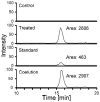Polyamines are traps for reactive intermediates in furan metabolism
- PMID: 21842885
- PMCID: PMC3221807
- DOI: 10.1021/tx200273z
Polyamines are traps for reactive intermediates in furan metabolism
Abstract
Furan is toxic and carcinogenic in rodents. Because of the large potential for human exposure, furan is classified as a possible human carcinogen. The detailed mechanism by which furan causes toxicity and cancer is not yet known. Since furan toxicity requires cytochrome P450-catalyzed oxidation of furan, we have characterized the urinary and hepatocyte metabolites of furan to gain insight into the chemical nature of the reactive intermediate. Previous studies in hepatocytes indicated that furan is oxidized to the reactive α,β-unsaturated dialdehyde, cis-2-butene-1,4-dial (BDA), which reacts with glutathione (GSH) to form 2-(S-glutathionyl)succinaldehyde (GSH-BDA). This intermediate forms pyrrole cross-links with cellular amines such as lysine and glutamine. In this article, we demonstrate that GSH-BDA also forms cross-links with ornithine, putrescine, and spermidine when furan is incubated with rat hepatocytes. The relative levels of these metabolites are not completely explained by hepatocellular levels of the amines or by their reactivity with GSH-BDA. Mercapturic acid derivatives of the spermidine cross-links were detected in the urine of furan-treated rats, which indicates that this metabolic pathway occurs in vivo. Their detection in furan-treated hepatocytes and in urine from furan-treated rats indicates that polyamines may play an important role in the toxicity of furan.
Figures








Similar articles
-
Trapping of cis-2-butene-1,4-dial to measure furan metabolism in human liver microsomes by cytochrome P450 enzymes.Drug Metab Dispos. 2012 Mar;40(3):596-601. doi: 10.1124/dmd.111.043679. Epub 2011 Dec 20. Drug Metab Dispos. 2012. PMID: 22187484 Free PMC article.
-
Degraded protein adducts of cis-2-butene-1,4-dial are urinary and hepatocyte metabolites of furan.Chem Res Toxicol. 2009 Jun;22(6):997-1007. doi: 10.1021/tx800377v. Chem Res Toxicol. 2009. PMID: 19441776 Free PMC article.
-
New insight into the molecular mechanism of protein cross-linking induced by cis-2-butene-1,4-dial, the metabolite of furan: Formation of 2-substituted pyrrole cross-links involving the cysteine and lysine residues.Bioorg Chem. 2022 Aug;125:105852. doi: 10.1016/j.bioorg.2022.105852. Epub 2022 May 5. Bioorg Chem. 2022. PMID: 35551004
-
Electrophilic intermediates produced by bioactivation of furan.Drug Metab Rev. 2006;38(4):615-26. doi: 10.1080/03602530600959417. Drug Metab Rev. 2006. PMID: 17145691 Review.
-
Reactive metabolites in the biotransformation of molecules containing a furan ring.Chem Res Toxicol. 2013 Jan 18;26(1):6-25. doi: 10.1021/tx3003824. Epub 2012 Oct 24. Chem Res Toxicol. 2013. PMID: 23061605 Free PMC article. Review.
Cited by
-
Structural characterisation and pH-dependent preference of pyrrole cross-link isoforms from reactions of oxoenal with cysteine and lysine side chains as model systems.Amino Acids. 2023 Sep;55(9):1073-1082. doi: 10.1007/s00726-023-03295-0. Epub 2023 Jul 11. Amino Acids. 2023. PMID: 37432478 Free PMC article.
-
Cross-linking protein glutathionylation mediated by O2-arylated bis-diazeniumdiolate "Double JS-K".Chem Res Toxicol. 2012 Dec 17;25(12):2670-7. doi: 10.1021/tx3003142. Epub 2012 Nov 9. Chem Res Toxicol. 2012. PMID: 23106594 Free PMC article.
-
Trapping of cis-2-butene-1,4-dial to measure furan metabolism in human liver microsomes by cytochrome P450 enzymes.Drug Metab Dispos. 2012 Mar;40(3):596-601. doi: 10.1124/dmd.111.043679. Epub 2011 Dec 20. Drug Metab Dispos. 2012. PMID: 22187484 Free PMC article.
-
Covalent modification of cytochrome c by reactive metabolites of furan.Chem Res Toxicol. 2014 Jan 21;27(1):129-35. doi: 10.1021/tx400368r. Epub 2013 Dec 23. Chem Res Toxicol. 2014. PMID: 24364757 Free PMC article.
-
Urinary metabolites of furan in waterpipe tobacco smokers compared to non-smokers in home settings in the US.Toxicol Lett. 2020 Oct 15;333:202-210. doi: 10.1016/j.toxlet.2020.08.002. Epub 2020 Aug 16. Toxicol Lett. 2020. PMID: 32814080 Free PMC article.
References
-
- National Toxicology Program. Toxicology and carcinogenesis studies of furan in F344/N rats and B6C3F1 mice vol NTP Technical Report No 402. US Department of Health and Human Services, Public Health Service, National Institutes of Health; Research Triangle Park, NC: 1993. - PubMed
-
- International Agency for Research on Cancer. Dry Cleaning, Some Chlorinated Solvents and Other Industrial Chemicals. IARC; Lyon, France: 1995. Furan; p. 393.
-
- Perez LC, Yaylayan VA. Origin and mechanistic pathways of formation of the parent furan--a food toxicant. J Agric Food Chem. 2004;52:6830–6836. - PubMed
-
- National Toxicology Program. 11th Report on Carcinogens. US Department of Health and Human Services; Washington DC: 2005.
-
- Carfagna MA, Held SD, Kedderis GL. Furan-induced cytolethality in isolated rat hepatocytes: Correspondence with in vivo dosimetry. Toxicol Appl Pharmacol. 1993;123:265–273. - PubMed
Publication types
MeSH terms
Substances
Grants and funding
LinkOut - more resources
Full Text Sources

